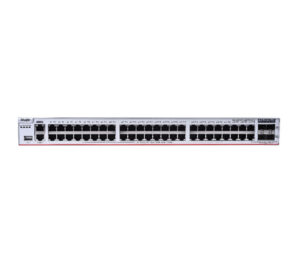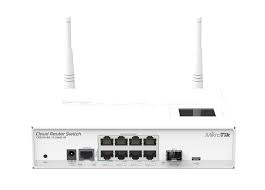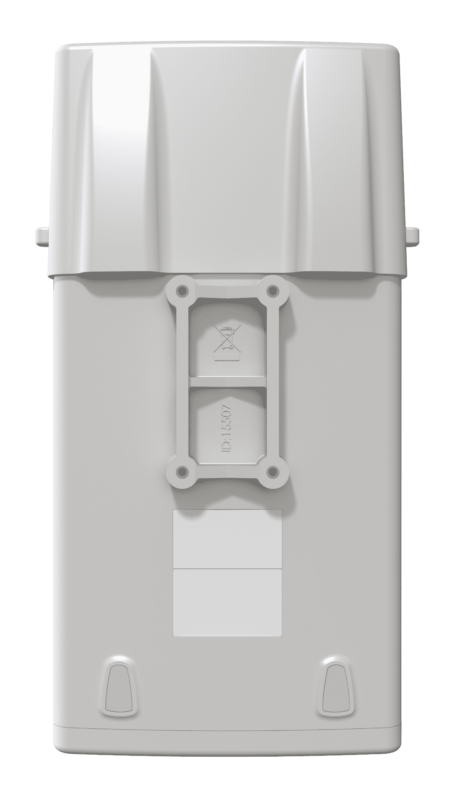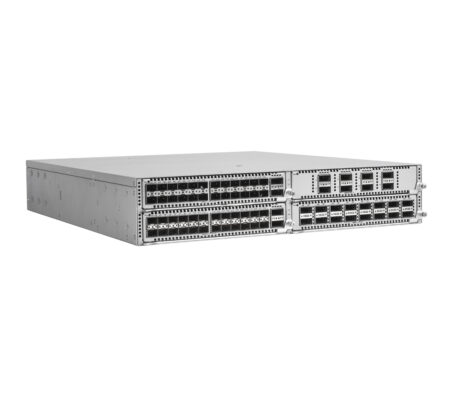Helps build unblocked data center networks and provides powerful cache capacity
The whole series of switches oriented towards next-generation data centers and cloud computing are line-rate products. They are in line with the development trend of bidirectional traffic between the Internet and data centers and are applicable to heavy-traffic next-generation data centers.
RG-S6510-4C is capable of providing 96x25G ports and 8x100G ports, 32x100G ports, or 64x40G ports in the 2U height, achieving 1:1 convergence ratio in the upstream and downstream direction. All the ports can forward data at the line rate.
In allusion to requirements for unblocked transmission of heavy-traffic data in data centers, RG-S6510-4C offers powerful cache capacity and uses the advanced cache scheduling mechanism, to ensure that the cache capacity of the device is effectively leveraged.
Implements virtualization in data centers
RG-S6510-4C adopts the virtual switch unit (VSU) 2.0 technology to virtualize multiple physical devices into one logical device, which reduces network nodes and enhances network reliability. These physical devices can be operated and managed in a unified manner. The switch can implement fast link switching within 50 ms to 200 ms in case of a failure, thereby ensuring uninterrupted transmission of key services. The inter-device link aggregation feature implements dual active uplinks for data through access servers and switches.
The device supports Ethernet VPN (EVPN) Virtual Extensible LAN (VXLAN), which overcomes network scale expansion difficulties caused by inadequate network VLANs in conventional data centers. The VXLAN technology encapsulates layer-2 packets into User Datagram Protocol (UDP) packets to build a logically layer-2 network on the layer-3 network. Users can deploy VXLAN without changing the original network architecture and flexibly migrate hosts (virtual machines) in data centers regardless of physical networks. In addition, network resources can be assigned to different new subnets without changing the physical topology, and restrictions on IP addresses and broadcast domains of physical networks do not need to be taken into account. The switch also introduces a reliable control plane protocol EVPN to automatically discover and authenticate virtual tunnel end point (VTEPs), thereby reducing flooding at the VXLAN data plane and preventing VXLAN from relying on deployed underlying multicast services. EVPN can learn layer-2 and layer-3 information of servers on the control plane, which is conducive to the robustness and extension of VXLANs. The switch supports anycast gateway, which can optimize the mutual server access traffic, provide layer-3 gateway redundancy, and support virtual machine migration.
Implements RDMA-based lossless Ethernet
The switch implements low-delay forwarding of the lossless Ethernet based on the Remote Direct Memory Access (RDMA) and optimizes service forwarding performance. It greatly reduces the operation cost per bit of the entire network and enhances the competitive edge of service products.
Provides hardware-based traffic visualization
Switch chips support the visualization hardware feature and can visualize the end-to-end traffic of complex multipath networks composed of multiple nodes. In this way, the forwarding path and delay of each session can be monitored in a centralized manner, thereby raising the fault locating efficiency by more than ten times.
Provides carrier-class reliability protection
RG-S6510-4C is equipped with built-in redundant power modules and modular fan assemblies. All interface boards, power modules, and fan modules can be hot-swapped without affecting normal running of the device. The switch provides fault detection and alarm functions for power modules and fans. It can automatically adjust the fan speed based on temperature changes, to better adapt to the environment in data centers. The device also provides multiple device-level and link-level reliability protection as well as overcurrent protection, overvoltage protection and overheating protection.
In addition, the switch supports Graceful Restart (GR), Bidirectional Forwarding Detection (BFD), and other mechanisms. They ensure appropriate network convergence time and normal running of services even if multiple services and heavy traffic are carried over the network.
Supports IPv4/IPv6 dual-stack protocols and multilayer switching
The hardware of RG-S6510-4C supports IPv4 and IPv6 protocol stacks and multilayer line-rate switching. The hardware differentiates and processes IPv4 and IPv6 packets and supports multiple tunnel technologies (such as manually configured tunnels, automatic tunnels, and Intra-Site Automatic Tunnel Addressing Protocol (ISATAP) tunnels). The switch can be used to flexibly build IPv6 inter-network communication solutions based on IPv6 network planning and network conditions.
The device supports numerous IPv4 routing protocols, including static routing, Routing Information Protocol (RIP), Open Shortest Path First (OSPF), Intermediate System to Intermediate System (IS-IS), Border Gateway Protocol version 4 (BGP4). Users can select required routing protocols based on network environments, to flexibly build networks.
The device also supports abundant IPv6 routing protocols, including static routing, Routing Information Protocol next generation (RIPng), OSPFv3, and BGP4+. Appropriate routing protocols can be selected to upgrade an existing network to an IPv6 network or build a new IPv6 network.
Provides flexible and complete security policies
RG-S6510-4C has a variety of internal mechanisms to effectively prevent and control virus propagation and hacker attacks to ensure green network environment. Such mechanisms include DoS attack prevention, anti-hacker IP scanning mechanism, port ARP packet validity check, and multiple hardware ACL strategies.
The hardware-based IPv6 ACL can easily control the access of IPv6 users at the network boundary even if there are IPv6 users on an IPv4 network. The switch supports the coexistence of IPv4 and IPv6 users and can control access permissions of IPv6 users, for example, restrict the access to sensitive resources on the network.
The telnet access control based on source IP addresses can prevent illegitimate users and hackers from maliciously attacking and controlling the device, enhancing the network management security of the device. The Secure Shell (SSH) and Simple Network Management Protocol version 3 (SNMPv3) can encrypt management information in the telnet and SNMP processes, thereby ensuring information security of the switch and preventing hackers from attacking and controlling the switch.
The switch rejects the network access from illegitimate users and enables legitimate users to use networks properly by employing multi-element binding, port security, time-based ACL, and data stream–based rate limit. It can strictly control the user access to enterprise networks and campus networks and restrict the communication of unauthorized users.
Provides all-round management performance
The switch provides various management interfaces such as the Console interface, MGMT interface, and USB interface, and supports SNMP v1/v2/v3 as well as universal network management platform and service management software such as BMC. It supports CLI-based management, telnet, and cluster management, which facilitates device management. The supported encryption modes such as SSH2.0 and SSL ensure more secure management.
In addition, the device supports the Switched Port Analyzer (SPAN)/Remote Switched Port Analyzer (RSPAN) and multiple SPAN observation ports. It can analyze network traffic and take proper management and maintenance measures accordingly, clearly presenting the service traffic on a network. The device can provide various network traffic analysis reports so that users can optimize the network structure and adjust resource deployment in a timely manner.












